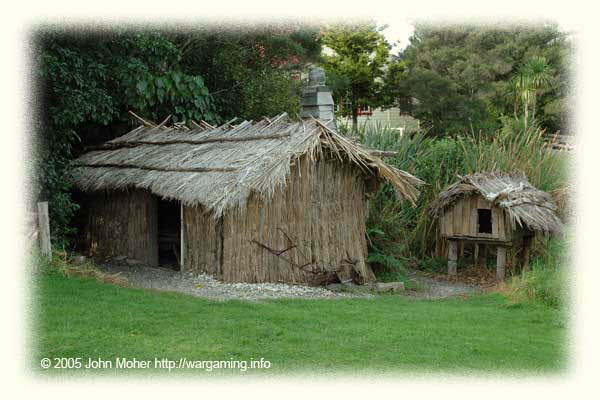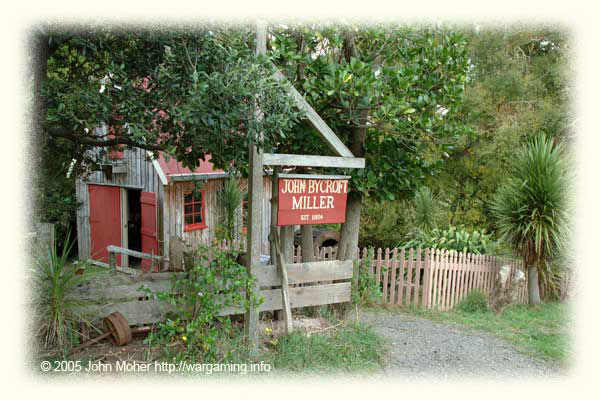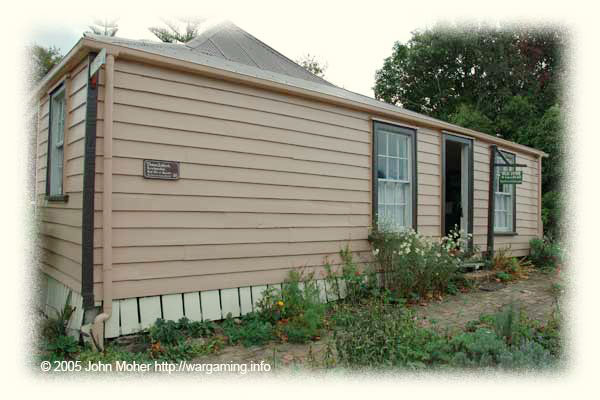New Zealand’s main Colonial Growth occurred in a period before and simultaneous to the American Civil War, as a result many major buildings from the 1840-1880 period closely resemble the same style of construction as was common in North America at the time of the American Civil War and before. By the 1870’s there appears to be a reasonably widespread introduction of corrugated iron (and of course in the main towns construction of large multi-story stone and similar buildings) – but this is essentially after the period we are interested in.

Fortunately I am lucky enough to live not far from the Howick Historical Village – this features numerous restored buildings from the Northland-Auckland-Waikato region as well as reconstructions of lesser buildings and both Civilian and Military re-enactors.
If you are ever in Auckland and interested in the Colonial Period it is well worth the visit for a modest fee. Meanwhile to assist those wargamers not lucky enough to have seen it, here’s a selection of photos of the main buildings to provide some ideas for what Colonial New Zealand settlements should look like…
The Fencibles: Tents & Raupo Housing
Fencible is a contraction of Defencible (i.e. able to defend) – in modern times the term ‘Home Guard’ or even ‘Self Defence Force’ might be used for the same purpose; effectively a ‘citizen’ Militia.
The Fencibles were the Colonial equivalent of the Home Guard. When Auckland was established a string of settlements were established on it’s southern side; Howick, Panmure, Otahuhu, and Onehunga, running East to West from coast to coast (at this point Auckland, or rather New Zealand, is literally only a few miles wide). Howick was the Eastern and most Southerly outpost on the north side of the East-Tamaki River Estuary, Panmure was North-West of Howick and at the next major water feature (the Panmure/Pakuranga Estuary – now a Lagoon). Otahuhu was centrally placed south of the main Auckland settlement, and Onehunga was a small port on the western Manukau Harbour.

To protect these settlements between 1847 and 1854 the British Colonial Authorities recruited veterans of the British Army and Royal Navy to come and live in New Zealand in return for their services – in essence a ‘Fencible’ and his wife (as most were married) would get a small 2 bedroom cottage on a (very) small plot of land, in return they would be issued a musket and equipment, be expected to drill with it regularly, and be required to turn out in defence of the Auckland settlements against the Maoris, French, or any other aggressor (yes there seems to have been a very real perceived fear the French would try to invade and take control of the Auckland-Northland region). In the case of Howick Village there was a small stockade built on the central dominant hill overlooking the village, intended for the woman and children to shelter in in case of attack and provide a focal point for the Fencibles and local settlers to rally around – the site is still visible today in the current Howick Village.

Many ex-Vets took up the offer (today they would be the modern equivalent of pensioners or retired people), it was a chance to escape the poverty and drudgery of Britain, and the poverty faced by many ex-servicemen during the industrial revolution, or for those of Irish descent the Great Potato Famine. Unfortunately, they got somewhat shafted, partially due to incompetence and partially due to crafty politicians! The government under-estimated how many cottages were needed, failed to supply sufficient materials, and generally mismanaged the whole process. Most Fencibles went through several years of hardship and when they finally got what was promised them, it was less than the original agreement!

More substantial Raupos




Fencible Cottages
So the government had promised the Fencibles who came to the Auckland region a nice little 2 bedroom cottage – but in true government style the whole thing was a botch up, they didn’t have enough materials, it was going to take far longer than planned to build the cottages, and it was going to cost a lot more too! Some Fencibles and other Settlers resorted to sod-brick style buildings in the interim…

So anyway the Government came up with a solution – cut them in half – so these already small 2 room cottages, on a tiny piece of land, were subsequently divided in half by just inserting a wall through the centre! This left a room at the back just big enough for a small double bed, and a slightly larger room in front to live/eat/wash/and store your possessions in!

The Fencibles themselves had even bigger issues – while they had been promised a cottage and land in return for forming a militia they actually had no source of income. The tiny plot of land with their cottage was further reduced by the act of halving each cottage site to make two, so effectively they often had perhaps a 6′-12′ strip of land around the edge of the cottage and a larger 12′-20′ square ‘back yard’ at the rear – in variably all this area was put to use growing food (Vegetables, Corn, Potato, Maori Potato, even Taro) and tobacco, the latter could be traded and was a fairly valuable commodity for bartering. Meanwhile it took the government several years to get around to building all the cottages it had promised during the recruiting drive from 1847-54 – I think the last one’s weren’t built until as late as 1860 or so.

Fencibles therefore still had to also work to earn enough to eat. Many worked as local labourers, barmen, wood cutters, and such like, and if necessary they would even stoop to Charcoal Burning – basically the lowest profession available in a New Zealand Colonial Settlement! Some inhabitants of Fencible Cottages had children, and there was literally no-where for them to go, so the usual solution was a trap door into the roof space and a removable ladder, and the children slept on some form of mattress or padding on the ceiling – there being just enough room to move around up there (the heat must have been intolerable at the peak of summer, especially as many cottages had, or were subsequently upgraded to, corrugated iron roofs).

Charcoal Burners
Charcoal burning was a dirty filthy job, and generally reserved for the lowest of the low, it was often the last stop before destitution for many, and often the province of alcoholics – yet according to Howick Historical Village it was an essential industry right up virtually to World War I and nearly everyone did it at sometime or other (as an alternate income when times were tough). Charcoal was required for Blacksmiths, Brick manufacturing, Paint, and Stoves & Irons. Not to mention the older uses of Glassmaking and Gunpowder (although these were on the way out by this time).

More Substantial Settlement Buildings
In the Auckland Region – particularly around the Howick and Panmure Settlements, the soil was (and still is) clay based and poor quality, in the 1840-50’s it was covered with low Titree scrub. This made farming difficult, both growing crops and grazing livestock (sheep & cattle). According to Howick Historical Village it was especially difficult in the South East, across the East-Tamaki River from Howick, in the Whitford area. As a result farmers tended to diversify and do a little of everything – crops would be scattered around in small patches where they would grow and could be Wheat, Oats, or Vegetables. A small Dairy Herd (literally a handful of cows) would be kept to get milk to make butter & cheese for sale, and pieces of Kauri Gum would be collected off the farmer’s land and sold. Finally Wood would be cut and either sold as firewood to other settlers, or used for resorting to the old favourite; Charcoal Burning!

The Howick settlement also featured a small port (well a jetty really, about a mile from the village over a ridge), something Panmure and Otahuhu didn’t have being inland. This meant that some vessels (e.g. schooners, small coastal vessels, etc) sometimes stopped into the area and discharged passengers or cargo directly, rather than at Auckland (where it had to be transported overland to its destination). Larger vessels could also discharge in some cases using their ship’s boats.





Homesteads and other Substantial Houses
Many (or rather most) larger New Zealand Colonial Homesteads and buildings had a lot in common with the clapboard and similar buildings of North America, and as such bear some resemblance to the buildings commonly seen in the American Civil War and such like.







Thanks John. When I next visit NZ I’ll pop in to have a look at the village.
If I stop by will the NPC Greg the Garlic Farmer be there? 😀
Maybe! If you get the day right 😉